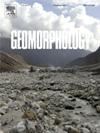Kura (Mtkvari) River terraces record fluvial response to the collision of the Greater and Lesser Caucasus thrust belts, Georgia
IF 3.1
2区 地球科学
Q2 GEOGRAPHY, PHYSICAL
引用次数: 0
Abstract
Near Tbilisi, Georgia, the Kura (Mtkvari) River flows across the junction between seismically active thrust belts in the Greater and Lesser Caucasus Mountains, near the locus of modern contractional strain within this sector of the Arabia-Eurasia collision. Here we describe and use a suite of fluvial terraces to explore the regional paleogeography, landscape evolution, and neotectonic development of the east end of the Adjara-Trialeti fold-thrust within the Lesser Caucasus. Specifically, we identified and mapped a suite of fluvial terraces within and around Tbilisi by integrating analyses of airborne LiDAR data with provenance observations from clast compositions and paleoflow directions from clast imbrication data. These data reveal three distinct types of fluvial strath terraces in the region: a main set from the Kura River and two secondary sets sourced from tributaries on its western (right) and eastern (left) banks. There are seventeen different elevation levels, with heights ranging from 10 to 690 m above the current river level of the Kura River. We infer that the Kura terraces are formed by local surface uplift above actively growing folds because they mainly occur in areas underlain by anticlines, therefore we find evidence of localized folding and faulting of terrace deposits. However, we are unable to determine if individual generations of terraces are folded, as this requires detailed terrace correlations that go beyond the initial mapping and dating, we report here. Based on our regional mapping and paleocurrent data, we conclude that the Kura River migrated over time from the northeast to the southwest. This migration is inferred to result from differential uplift in this part of the Adjara-Trialeti fold-thrust belt, with active collision between the Greater and Lesser Caucasus in the northeast causing enhanced surface uplift, pushing the river towards the southwest.
在格鲁吉亚第比利斯附近,库拉河(Mtkvari)流经大高加索山脉和小高加索山脉地震活动推力带的交界处,靠近阿拉伯-欧亚碰撞这一部分现代收缩应变的位置。在这里,我们描述并利用一套河流阶地,探索小高加索地区内阿扎尔-特里亚雷蒂褶皱推力带东端的区域古地理、地貌演变和新构造发展。具体而言,我们通过对机载激光雷达数据的分析、从碎屑成分中观察到的产地以及从碎屑嵌合数据中观察到的古水流方向进行整合,确定并绘制了第比利斯及其周边地区的一系列河流阶地。这些数据揭示了该地区三种不同类型的河曲阶地:库拉河的主阶地和库拉河西岸(右岸)和东岸(左岸)支流的两套次阶地。有 17 个不同的海拔高度,高度从库拉河当前河面以上 10 米到 690 米不等。我们推断库拉阶地是由活跃生长的褶皱上的局部地表隆起形成的,因为它们主要出现在反斜坡下的地区,因此我们发现了阶地沉积物局部褶皱和断层的证据。不过,我们无法确定每一代阶地是否都有褶皱,因为这需要进行详细的阶地关联,而这超出了我们在此报告的初步测绘和年代测定的范围。根据我们的区域测绘和古水流数据,我们得出结论,库拉河随着时间的推移从东北部向西南部迁移。据推断,这种迁移是由于阿扎尔-特里亚雷蒂褶皱-推力带这一部分的不同隆起造成的,东北部大高加索山脉和小高加索山脉之间的激烈碰撞导致地表隆起加剧,将库拉河推向西南。
本文章由计算机程序翻译,如有差异,请以英文原文为准。
求助全文
约1分钟内获得全文
求助全文
来源期刊

Geomorphology
地学-地球科学综合
CiteScore
8.00
自引率
10.30%
发文量
309
审稿时长
3.4 months
期刊介绍:
Our journal''s scope includes geomorphic themes of: tectonics and regional structure; glacial processes and landforms; fluvial sequences, Quaternary environmental change and dating; fluvial processes and landforms; mass movement, slopes and periglacial processes; hillslopes and soil erosion; weathering, karst and soils; aeolian processes and landforms, coastal dunes and arid environments; coastal and marine processes, estuaries and lakes; modelling, theoretical and quantitative geomorphology; DEM, GIS and remote sensing methods and applications; hazards, applied and planetary geomorphology; and volcanics.
 求助内容:
求助内容: 应助结果提醒方式:
应助结果提醒方式:


